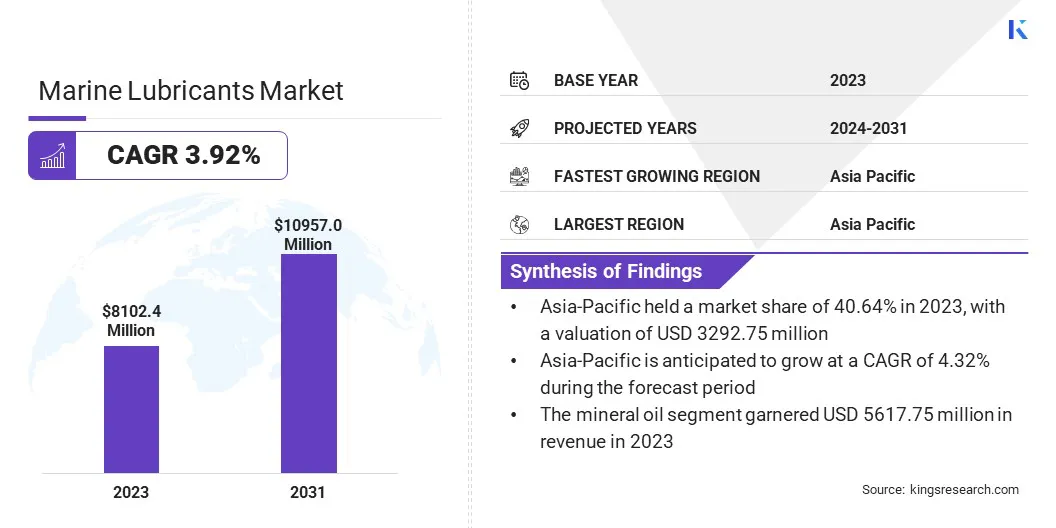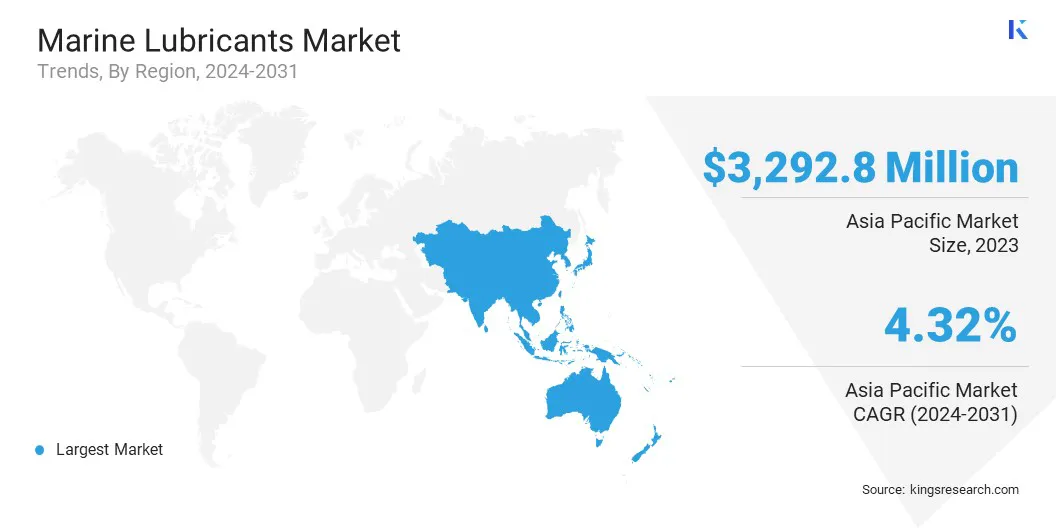Market Definition
The market focuses on the production, distribution, and sale of specialized lubricants used in marine vessels to enhance engine performance, reduce friction, and prevent wear & tear. These lubricants, including engine oils, hydraulic fluids, and greases, are essential for ensuring the smooth operation of various ship components, such as engines, turbines, and compressors.
The report provides insights into the fundamental drivers steering market growth, complemented by a thorough evaluation of market trends and the regulatory frameworks governing industry operations.
Marine Lubricants Market Overview
The global marine lubricants market size was valued at USD 8102.4 million in 2023 and is projected to grow from USD 8372.06 million in 2024 to USD 10957.02 million by 2031, exhibiting a CAGR of 3.92% during the forecast period.
The market is fueled by increasing global maritime trade, rising demand for fuel-efficient & environmentally friendly lubricants, and stringent regulations imposed by organizations such as the International Maritime Organization (IMO) to curb emissions.
The expansion of commercial shipping fleets, along with advancements in lubricant formulations that enhance engine performance and reduce maintenance costs, further contributes to market growth.
Major companies operating in the marine lubricants industry are Exxon Mobil Corporation, TotalEnergies.com, Gulf Oil International Ltd, Shell International B.V., Sinopec Lubricant Pte Ltd, ENEOS Corporation, BP p.l.c., Repsol, Gazpromneft - Lubricants Ltd., Chevron Corporation, Klüber Lubrication München GmbH & Co. KG, SK ZIC, LUKOIL, Calumet Branded Products, and Enilive SpA.
Rising adoption of bio-based and synthetic lubricants, along with ongoing innovations in additive technologies, is expected to present significant opportunities for industry stakeholders. Additionally, the increasing adoption of bio-based and synthetic lubricants, along with technological innovations in lubricant additives, is expected to create opportunities for market players.
- In November 2024, Chevron Marine Lubricants announced the expansion of its supply network to Port Elizabeth, South Africa, further strengthening its global distribution reach. This strategic move enhances lubricant availability for shipping operators in the region, ensuring reliable access to high-quality products essential for vessel maintenance and efficiency.

Key Highlights:
- The marine lubricants industry size was valued at USD 8102.4 million in 2023.
- The market is projected to grow at a CAGR of 3.92% from 2024 to 2031.
- Asia-Pacific held a market share of 40.64% in 2023, with a valuation of USD 3292.75 million.
- The mineral oil segment garnered USD 5617.75 million in revenue in 2023.
- The engine oils segment is expected to reach USD 4993.08 million by 2031.
- The container ships segment is anticipated to register the fastest CAGR of 4.44% during the forecast period.
- The market in North America is anticipated to grow at a CAGR of 3.98% during the forecast period.
Market Driver
Growth in Global Maritime Trade
The expansion of global maritime trade serves as a fundamental driver of the market, as the shipping industry facilitates over 80% of global merchandise transportation. Rising demand for consumer goods, energy resources, and raw materials has increased seaborne trade, necessitating efficient vessel maintenance.
Rapid industrialization, export growth, and the surge in container shipping further drive the demand for lubricants. High-performance lubricants enhance engine efficiency, reduce maintenance costs, and improve fuel economy, supporting fleet optimization. Investments in port infrastructure and logistics continue to strengthen global trade, ensuring sustained demand for marine lubricants.
- In June 2024, ENOC Company recorded a 120% increase in sales for its marine lubricants business in the Greek market, marking a significant milestone in its global expansion strategy. The surge in demand is attributed to the company’s commitment to providing high-quality lubrication solutions that enhance vessel performance and meet regulatory standards.
Market Challenge
Volatility in Crude Oil Prices
Price volatility of crude oil directly impacts the marine lubricants market, influencing production costs, pricing strategies, and profit margins. Fluctuations in global oil prices, influenced by geopolitical tensions, supply-demand dynamics, and macroeconomic uncertainties, directly affect lubricant manufacturing costs.
Sharp price increases elevate production expenses, squeezing profit margins and leading to higher end-user prices, while sudden declines can create market instability, impacting investment in innovation and sustainable alternatives. Reliance on crude oil exposes the market to risks related to supply chain disruptions, regulatory shifts, and the growing transition toward alternative energy sources.
Manufacturers of marine lubricants can adopt diversified sourcing strategies to ensure a stable supply of raw materials and reduce dependency on crude oil.
Investing in synthetic and bio-based lubricants can provide more stable cost structures while aligning with environmental regulations. Implementing dynamic pricing models and advancing R&D in efficient formulations can reduce reliance on traditional base oils, ensuring cost stability and long-term sustainability.
Market Trend
Growing Demand for Bio-based and Synthetic Lubricants
A notable trend in the market is the growing demand for bio-based and synthetic lubricants, due to the increasing environmental regulations, sustainability initiatives, and the need for high-performance alternatives to conventional mineral-based oils.
These advanced lubricants offer superior biodegradability, reduced emissions, and enhanced engine efficiency, aligning with global efforts to reduce the environmental impact of maritime operations. The International Maritime Organization (IMO) regulations and government incentives promoting eco-friendly solutions are further accelerating the shift toward these advanced lubricants.
Shipping companies are increasingly adopting bio-based and synthetic options to comply with stringent emissions norms while improving vessel performance and operational sustainability.
- In May 2023, Exxon Mobil Corporation signed an agreement to supply B30 marine biofuel oil in the Amsterdam-Rotterdam-Antwerp (ARA) region, reinforcing its commitment to sustainable maritime solutions. The initiative supports the shipping industry’s transition to lower-emission fuels while ensuring compliance with evolving environmental regulations.
Marine Lubricants Market Report Snapshot
|
Segmentation
|
Details
|
|
By Oil Type
|
Mineral Oil, Synthetic Oil, Bio-based Oil
|
|
By Product Type
|
Engine Oils, Cylinder Oils, System Oils, Hydraulic Fluid, Compressor Oils, Others
|
|
By Ship Type
|
Bulk Carriers, Tankers, Container Ships, Others
|
|
By Region
|
North America: U.S., Canada, Mexico
|
|
Europe: France, UK, Spain, Germany, Italy, Russia, Rest of Europe
|
|
Asia-Pacific: China, Japan, India, Australia, ASEAN, South Korea, Rest of Asia-Pacific
|
|
Middle East & Africa: Turkey, UAE, Saudi Arabia, South Africa, Rest of Middle East & Africa
|
|
South America: Brazil, Argentina, Rest of South America
|
Market Segmentation
- By Oil Type (Mineral Oil, Synthetic Oil, Bio-based Oil): The mineral oil segment earned USD 5617.75 million in 2023, due to its cost-effectiveness, widespread availability, and extensive use in commercial shipping and naval operations.
- By Product Type (Engine Oils, Cylinder Oils, System Oils, Hydraulic Fluid, Compressor Oils, Others): The engine oils segment held 45.21% share of the market in 2023, due to its critical role in ensuring engine performance, reducing friction and extending equipment lifespan in marine vessels.
- By Ship Type (Bulk Carriers, Tankers, Container Ships, Others): The bulk carriers segment is projected to reach USD 3932.47 million by 2031, owing to the increasing demand for dry bulk commodities, expanding global trade, and the growing fleet size of bulk carriers requiring regular lubrication for efficient operation.
Marine Lubricants Market Regional Analysis
Based on region, the global market has been classified into North America, Europe, Asia Pacific, Middle East & Africa, and Latin America.

North America accounted for 40.64% share of the marine lubricants market in 2023, with a valuation of USD 3292.75 million. The dominance is reinforced by the region’s position as a global hub for shipbuilding, maritime trade, and port activities. Countries such as China, South Korea, and Japan have well-established shipping industries and extensive commercial fleets, contributing to high lubricant consumption.
The region's strong industrial base and increasing exports fuel the demand for cargo transportation, further supporting market growth. Government initiatives promoting maritime infrastructure development and rising investments in fleet modernization also play a crucial role.
- In July 2023, Exxon Mobil Corporation successfully completed two commercial deliveries of bio-based marine fuel oil in the port of Singapore, marking a significant step in its commitment to sustainable shipping solutions. These deliveries demonstrate ExxonMobil’s ability to provide low-emission fuel alternatives that help vessel operators meet evolving environmental regulations.
The marine lubricants industry in North America is likely to grow at a CAGR of 3.98% over the forecast period. This growth is fostered by the increasing maritime trade, rising offshore oil & gas exploration activities, and stringent environmental regulations promoting the use of high-performance lubricants.
The presence of major shipping routes, expanding naval operations, and technological advancements in lubricant formulations further support market growth. Additionally, rising investments in sustainable and bio-based lubricants, along with measures to enhance fuel efficiency and cut emissions, are fueling the market.
Regulatory Frameworks
- In the U.S., the EPA Vessel General Permit (VGP) mandates the use of Environmentally Acceptable Lubricants (EALs) in all oil-to-sea interfaces of vessels operating in U.S. waters. This regulation ensures that lubricants used in marine applications are biodegradable, minimally toxic, and non-bioaccumulative, reducing the environmental impact of lubricant discharge into aquatic ecosystems.
- In India, the Maritime Zones of India Act (1981) and the Merchant Shipping Act (1958) regulate marine pollution, aligning with MARPOL and international standards. The Indian Coast Guard enforces these laws to prevent oil spills, control waste discharge, and promote the use of eco-friendly marine lubricants to protect the country’s coastal and marine ecosystems.
- MARPOL Annex VI, enforced under the Act to Prevent Pollution from Ships (APPS), regulates air pollution from vessels by setting limits on sulfur oxide (SOx) and nitrogen oxide (NOx) emissions and establishing fuel sulfur content restrictions.
- In Australia, the Protection of the Sea (Prevention of Pollution from Ships) Act 1983 enforces MARPOL regulations to prevent marine pollution from oil, chemicals, sewage, and garbage. Administered by the Australian Maritime Safety Authority (AMSA), this law mandates the use of environmentally compliant marine lubricants and strict pollution control measures to safeguard marine ecosystems.
- In the U.S., the Clean Water Act (CWA) regulates the discharge of pollutants, including oil & lubricants, into navigable waters by establishing water quality standards and permitting requirements.
Competitive Landscape
The marine lubricants industry is characterized by the presence of key players focusing on product innovation, strategic partnerships, and geographic expansion to strengthen their market position. Leading companies are investing in research and development to develop high-performance, environmentally friendly lubricants that comply with evolving regulatory standards.
Mergers, acquisitions, and collaborations with shipping companies and OEMs are common strategies to enhance distribution networks and expand customer reach. Manufacturers are leveraging digital technologies and advanced monitoring systems to improve lubricant efficiency and optimize maintenance schedules, further increasing their competitive edge in the market.
- In March 2024, Chevron Marine Lubricants and Petrol Ofisi hosted a joint technical event, bringing together industry experts to discuss advancements in marine lubrication technology. The event focused on enhancing vessel efficiency, regulatory compliance, and the latest innovations in lubricant formulations.
List of Key Companies in Marine Lubricants Market:
- Exxon Mobil Corporation
- TotalEnergies.com
- Gulf Oil International Ltd
- Shell International B.V.
- Sinopec Lubricant Pte Ltd
- ENEOS Corporation
- BP p.l.c.
- Repsol
- Gazpromneft - Lubricants Ltd.
- Chevron Corporation
- Klüber Lubrication München GmbH & Co. KG
- SK ZIC
- LUKOIL
- Calumet Branded Products
- Enilive SpA
Recent Developments (M&A/Partnerships/Agreements/Product Launches)
- In July 2024, TotalEnergies acquired Tecoil, a specialist in used oil regeneration, to strengthen its commitment to the circular economy in lubricants across Europe. This acquisition enhances TotalEnergies' ability to produce sustainable, high-quality lubricants by integrating regenerated base oils into its supply chain.
- In April 2024, Castrol Limited introduced its new TLX range of marine lubricants, designed to enhance engine performance and improve operational efficiency for modern vessels. The TLX range features advanced formulations that offer superior protection against wear, deposit buildup, and fuel contamination, ensuring compliance with stringent marine industry regulations.
- In September 2023, Al Maha Petroleum Products Marketing Co. S.A.O.G announced a strategic partnership with Al Qalaf Marine to enhance marine fuel and lubricant supply services. This collaboration aims to strengthen Al Maha’s presence in the maritime sector by providing high-quality fuel and lubrication solutions tailored to the needs of vessel operators.


